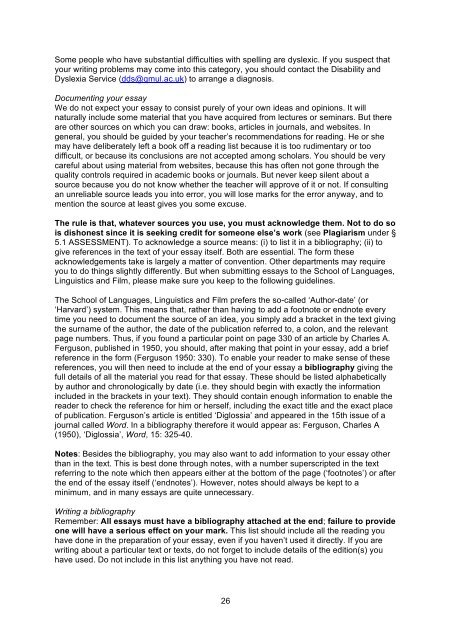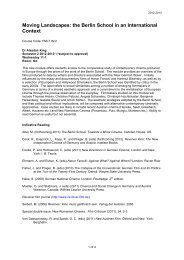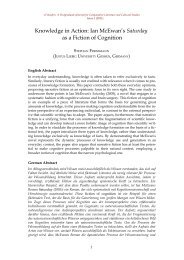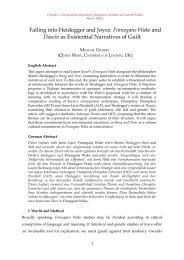Student Handbook - The School of Language, Linguistics and Film
Student Handbook - The School of Language, Linguistics and Film
Student Handbook - The School of Language, Linguistics and Film
Create successful ePaper yourself
Turn your PDF publications into a flip-book with our unique Google optimized e-Paper software.
Some people who have substantial difficulties with spelling are dyslexic. If you suspect that<br />
your writing problems may come into this category, you should contact the Disability <strong>and</strong><br />
Dyslexia Service (dds@qmul.ac.uk) to arrange a diagnosis.<br />
Documenting your essay<br />
We do not expect your essay to consist purely <strong>of</strong> your own ideas <strong>and</strong> opinions. It will<br />
naturally include some material that you have acquired from lectures or seminars. But there<br />
are other sources on which you can draw: books, articles in journals, <strong>and</strong> websites. In<br />
general, you should be guided by your teacher’s recommendations for reading. He or she<br />
may have deliberately left a book <strong>of</strong>f a reading list because it is too rudimentary or too<br />
difficult, or because its conclusions are not accepted among scholars. You should be very<br />
careful about using material from websites, because this has <strong>of</strong>ten not gone through the<br />
quality controls required in academic books or journals. But never keep silent about a<br />
source because you do not know whether the teacher will approve <strong>of</strong> it or not. If consulting<br />
an unreliable source leads you into error, you will lose marks for the error anyway, <strong>and</strong> to<br />
mention the source at least gives you some excuse.<br />
<strong>The</strong> rule is that, whatever sources you use, you must acknowledge them. Not to do so<br />
is dishonest since it is seeking credit for someone else’s work (see Plagiarism under §<br />
5.1 ASSESSMENT). To acknowledge a source means: (i) to list it in a bibliography; (ii) to<br />
give references in the text <strong>of</strong> your essay itself. Both are essential. <strong>The</strong> form these<br />
acknowledgements take is largely a matter <strong>of</strong> convention. Other departments may require<br />
you to do things slightly differently. But when submitting essays to the <strong>School</strong> <strong>of</strong> <strong>Language</strong>s,<br />
<strong>Linguistics</strong> <strong>and</strong> <strong>Film</strong>, please make sure you keep to the following guidelines.<br />
<strong>The</strong> <strong>School</strong> <strong>of</strong> <strong>Language</strong>s, <strong>Linguistics</strong> <strong>and</strong> <strong>Film</strong> prefers the so-called ‘Author-date’ (or<br />
‘Harvard’) system. This means that, rather than having to add a footnote or endnote every<br />
time you need to document the source <strong>of</strong> an idea, you simply add a bracket in the text giving<br />
the surname <strong>of</strong> the author, the date <strong>of</strong> the publication referred to, a colon, <strong>and</strong> the relevant<br />
page numbers. Thus, if you found a particular point on page 330 <strong>of</strong> an article by Charles A.<br />
Ferguson, published in 1950, you should, after making that point in your essay, add a brief<br />
reference in the form (Ferguson 1950: 330). To enable your reader to make sense <strong>of</strong> these<br />
references, you will then need to include at the end <strong>of</strong> your essay a bibliography giving the<br />
full details <strong>of</strong> all the material you read for that essay. <strong>The</strong>se should be listed alphabetically<br />
by author <strong>and</strong> chronologically by date (i.e. they should begin with exactly the information<br />
included in the brackets in your text). <strong>The</strong>y should contain enough information to enable the<br />
reader to check the reference for him or herself, including the exact title <strong>and</strong> the exact place<br />
<strong>of</strong> publication. Ferguson’s article is entitled ‘Diglossia’ <strong>and</strong> appeared in the 15th issue <strong>of</strong> a<br />
journal called Word. In a bibliography therefore it would appear as: Ferguson, Charles A<br />
(1950), ‘Diglossia’, Word, 15: 325-40.<br />
Notes: Besides the bibliography, you may also want to add information to your essay other<br />
than in the text. This is best done through notes, with a number superscripted in the text<br />
referring to the note which then appears either at the bottom <strong>of</strong> the page (‘footnotes’) or after<br />
the end <strong>of</strong> the essay itself (‘endnotes’). However, notes should always be kept to a<br />
minimum, <strong>and</strong> in many essays are quite unnecessary.<br />
Writing a bibliography<br />
Remember: All essays must have a bibliography attached at the end; failure to provide<br />
one will have a serious effect on your mark. This list should include all the reading you<br />
have done in the preparation <strong>of</strong> your essay, even if you haven’t used it directly. If you are<br />
writing about a particular text or texts, do not forget to include details <strong>of</strong> the edition(s) you<br />
have used. Do not include in this list anything you have not read.<br />
26







